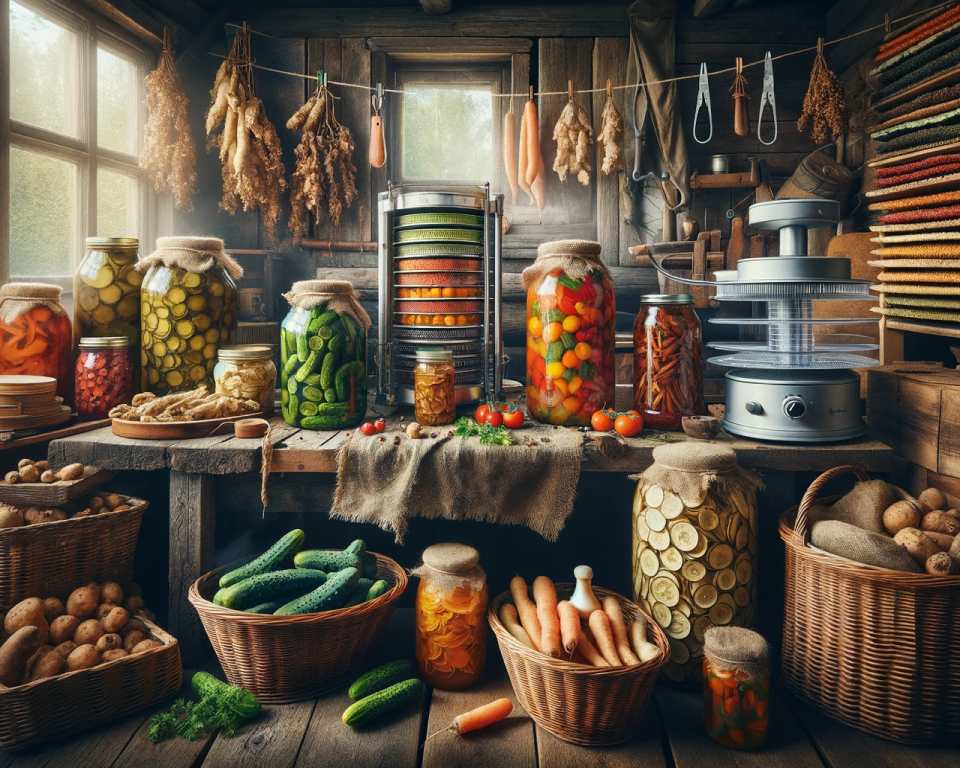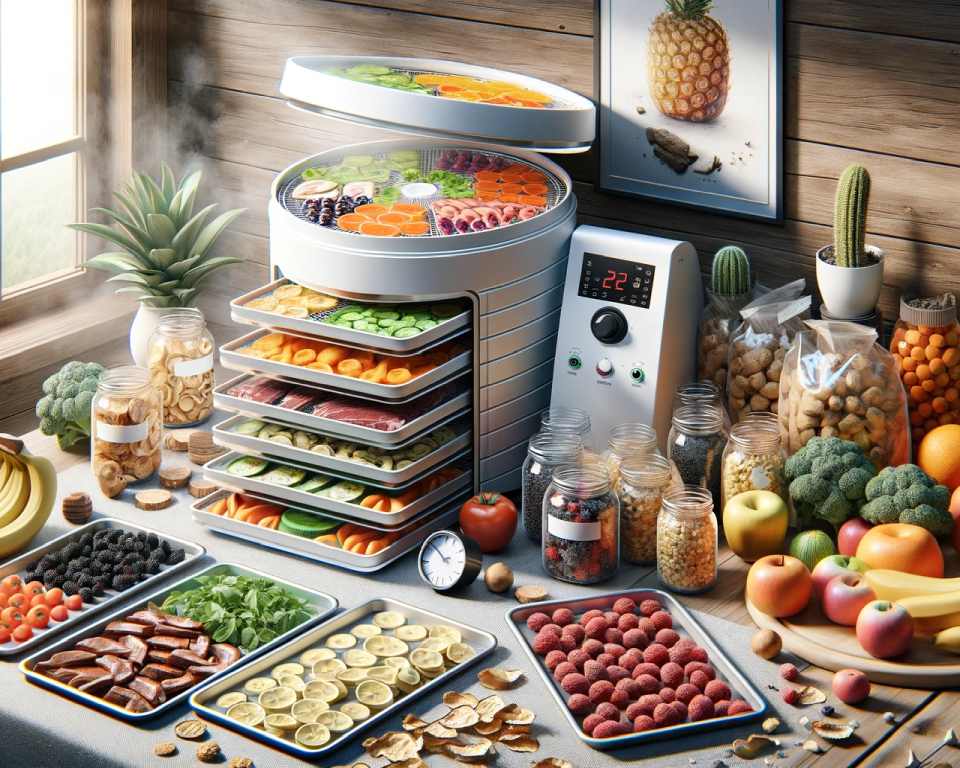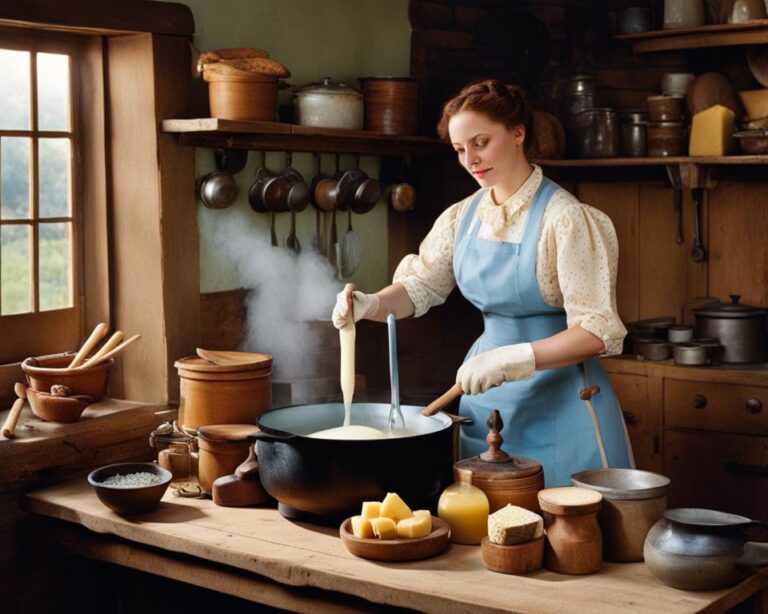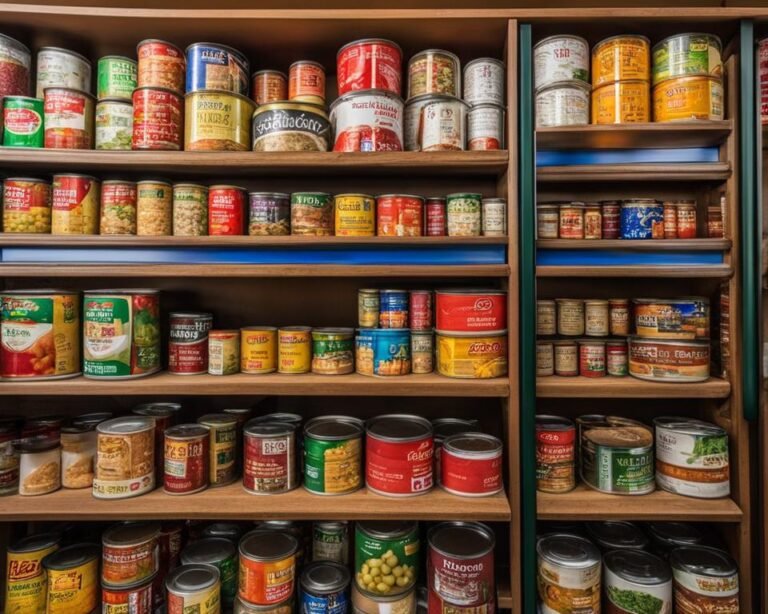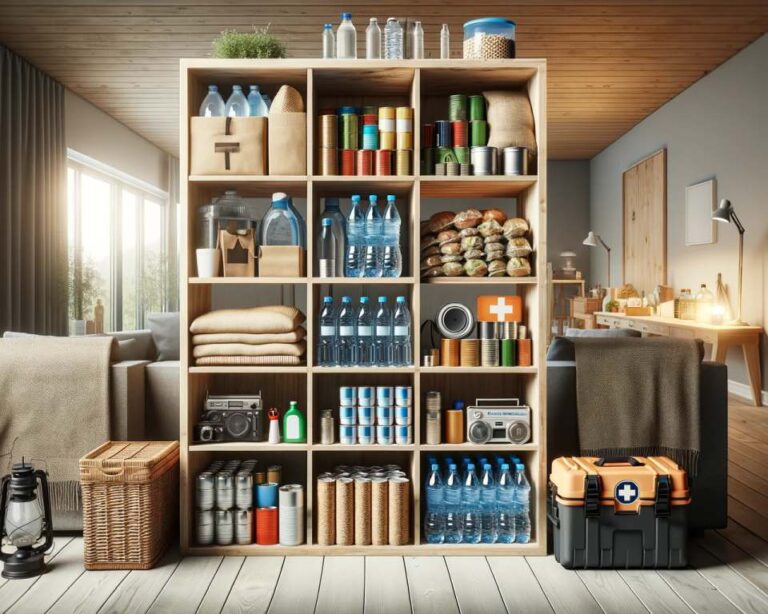Survival Food Preservation: Techniques Without Modern Conveniences
In today’s modern world, we often take for granted the convenience of easily accessible food and advanced preservation methods. However, there are still situations where these modern conveniences may not be available, such as during emergencies or in remote areas. In these challenging circumstances, knowing survival food preservation techniques becomes essential for ensuring long-term food storage and survival.
At [OUR BRAND], we understand the importance of being prepared for any situation. That’s why we have put together this comprehensive guide to survival food preservation methods that can be implemented without relying on modern technology.
Throughout this guide, we will explore various techniques, ranking them based on difficulty, time needed, energy usage, shelf life, and cost. From freezing and fermentation to canning and drying, these methods offer practical solutions for storing food over extended periods when traditional means are not available.
Whether you’re a seasoned homesteader or just getting started in self-sufficiency, this guide will equip you with the knowledge you need to ensure your emergency food storage is ready for any situation.
Freezing
Freezing is an easy and effective method of food preservation that allows us to store a wide variety of foods for extended periods. It is especially useful for long-term food storage, providing a convenient way to keep our favorite fruits, vegetables, and meats fresh for years to come.
One of the key advantages of freezing is its ability to prevent spoilage by slowing down the growth of bacteria, yeast, and molds. However, it’s important to note that freezing requires electricity to operate a freezer, which may impact energy consumption.
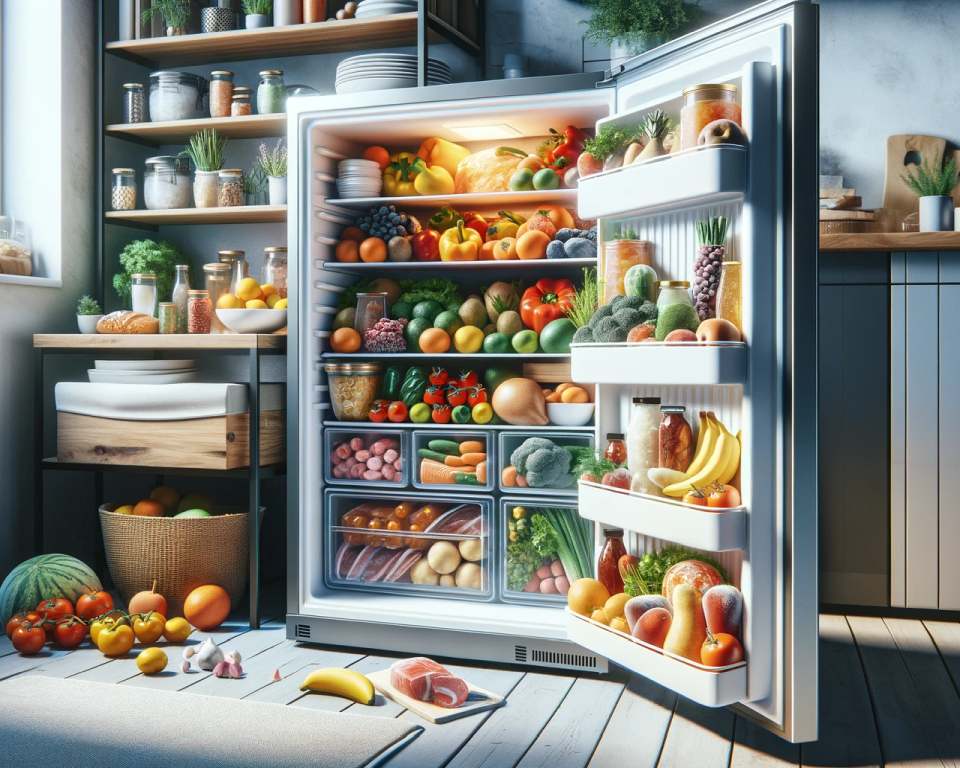
To ensure the best results, it is vital to properly seal the food before freezing. Inadequate sealing can lead to an issue called freezer burn, which causes the food to become dehydrated and develop a tough, dry texture. To combat this, vacuum sealing is an effective technique that removes excess air, reducing the risk of freezer burn and extending the shelf life of frozen foods.
Freezing is suitable for a wide range of food items, including fruits, vegetables, and meats. Whether you want to freeze fresh berries for smoothies, store bulk purchases of meat, or preserve excess produce from your garden, freezing offers a convenient and versatile solution.
“Freezing is a go-to preservation method for its simplicity and effectiveness in preserving the natural flavors and nutrients of food.” – Expert Preservationist
Additionally, freezing offers the advantage of retaining the nutritional value and quality of the food. By properly freezing the items, we can prolong their shelf life while minimizing nutrient loss.
Fermentation
Fermentation is an easy and low-energy method of food preservation. It harnesses the natural process of microorganisms converting sugars into acids or alcohol. By creating an acidic environment, fermentation inhibits the growth of harmful bacteria, allowing foods to be preserved for extended periods.
Fermentation can be used to preserve a wide range of foods, including vegetables, fruits, grains, and dairy products. This ancient technique not only extends the shelf life of foods but also enhances their nutritional value.
During the fermentation process, the natural bacteria present on the surface of the food or introduced through a starter culture break down sugars, producing lactic acid or alcohol. This creates a distinct tangy or sour flavor, which is characteristic of fermented foods. At the same time, the bacteria also produce enzymes that break down complex carbohydrates, increasing the bioavailability of nutrients.
Pickling: a form of fermentation
Pickling is a popular form of fermentation that uses a high-acid solution, usually vinegar or brine, to preserve foods. Vegetables, such as cucumbers, carrots, and cabbage, are commonly pickled. The acidity of the pickling solution prevents the growth of spoilage-causing bacteria, allowing the vegetables to be safely stored for an extended period without refrigeration.
Not only does pickling help prolong the shelf life of vegetables, but it also imparts a unique tang and crunch. Pickles can be enjoyed as a snack, used to add flavor to sandwiches or salads, or served as a flavorful accompaniment to a variety of dishes.
“Fermentation is a traditional method of food preservation that offers both taste and nutritional benefits.”
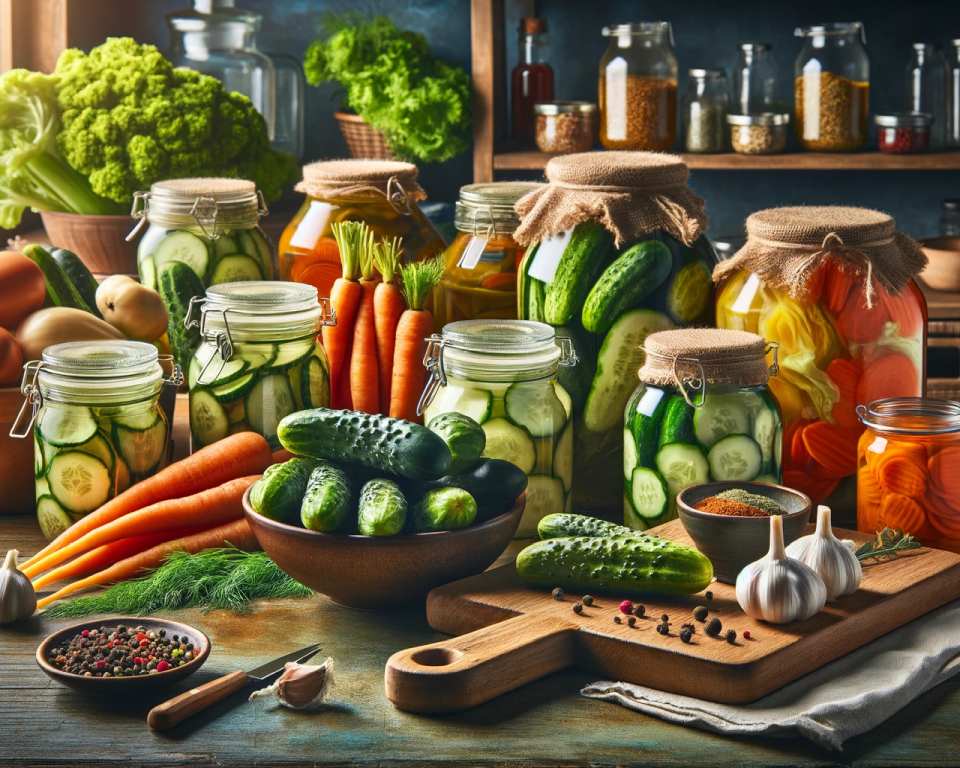
Fermentation is an attractive food preservation method due to its simplicity, low energy use, and the range of flavors it imparts. Incorporating fermented foods into our diet can be a delicious way to enhance our meals while benefiting from the increased nutritional value.
- Fermentation is an easy and low-energy food preservation method.
- It allows for the preservation of various foods: vegetables, fruits, grains, and dairy products.
- Pickling, a form of fermentation, uses high-acid solutions to preserve foods.
- Enjoy the tangy, sour flavors of fermented foods.
- Enhance your meals and boost nutrition with fermented foods.
Canning
Canning is a harder method of food preservation that requires a significant amount of time, energy, and special equipment. It involves sealing food in jars and heating them to kill bacteria and create a vacuum seal. Canned foods can last for years and are suitable for fruits, vegetables, and meats. However, there are concerns about botulism, a potentially deadly bacteria that can grow in improperly canned foods.
When it comes to shelf life, canned foods are hard to beat. Properly canned foods can stay fresh and nutritious for years, making them a great option for long-term food storage. However, the canning process requires a high energy use due to the need for heating and sterilization. This can be a drawback for those looking to reduce their energy consumption.
It’s important to note that botulism concerns are a significant consideration when canning food. Botulism is a type of food poisoning caused by the toxin produced by the bacterium Clostridium botulinum. This bacterium can survive and grow in low-acid, anaerobic environments like improperly canned foods. To ensure safety, it is crucial to follow proper canning procedures, including using the correct equipment, processing times, and acidity levels.
Drying
Drying is an easy and energy-efficient method of preserving food without the need for electricity. This technique involves removing moisture from foods to prevent spoilage and extend their shelf life. Dried foods can last for months and are suitable for various types of food, including fruits, herbs, grains, and meats.
Key Benefits of Drying:
- Long Preservation Time: Dried foods can last for months, making them an excellent choice for long-term storage.
- Low Energy Use: Unlike other preservation methods that rely on electricity, drying can be done using natural methods such as air drying or sun drying, minimizing energy consumption.
- Retained Flavor and Nutritional Value: The drying process helps to preserve the flavor, texture, and nutritional content of the food.
Whether you’re looking to preserve your harvest or create lightweight, portable snacks for outdoor adventures, drying is a versatile and practical food preservation technique.
“Drying is an easy and energy-efficient method of food preservation that results in long-lasting, flavorful, and nutritious dried foods.”
Freeze Drying
When it comes to preserving food, freeze drying is an excellent method that offers a long shelf life and minimal loss of flavor and nutritional value. This preservation technique involves freezing the food and then removing the moisture through a process called sublimation. As a result, the food is transformed into a lightweight, dry state that can be stored for extended periods of time.
Freeze drying is suitable for most types of foods, including fruits, vegetables, meats, and even complete meals. By removing the water content, freeze-dried foods become significantly lighter and easier to transport, making them a popular choice for camping trips, backpacking adventures, and emergency food supplies.
One of the key advantages of freeze drying is its ability to retain the original taste and nutritional value of the food. Unlike other preservation methods that may compromise the flavor and nutrients, freeze-dried foods maintain their natural qualities, ensuring a satisfying and nourishing culinary experience when rehydrated.
The Benefits of Freeze Drying:
- Long Shelf Life: Freeze-dried foods have an impressive shelf life, often lasting for several years. This extended shelf life makes them a reliable option for long-term food storage or emergency preparedness.
- Lightweight and Portable: With most of their water content removed, freeze-dried foods are incredibly lightweight and easy to carry. This makes them a convenient choice for outdoor activities or situations where weight is a concern.
- Retains Nutritional Value: Freeze drying preserves the nutritional integrity of foods, ensuring that essential vitamins, minerals, and enzymes remain intact.
Although freeze drying offers numerous advantages, it’s important to note that it can be an expensive preservation method. The specialized equipment required for freeze drying can be costly, making it less accessible for the average home pantry. However, for those willing to invest in the equipment, freeze drying can be a worthwhile endeavor, providing long-lasting, high-quality preserved foods.
“Freeze drying is a game-changer in the world of food preservation. It allows us to enjoy the taste and nutrition of our favorite foods for years to come.” – Food Preservation Enthusiast
Vacuum Sealing
When it comes to preserving dry or frozen foods, vacuum sealing is an essential technique. By removing the oxygen from a bag or container, vacuum sealing creates an airtight seal that keeps food fresh for extended periods of time. This method is ideal for long-term storage of various foods.
With vacuum-sealed foods, you can enjoy the convenience of having ready-to-eat meals on hand, even during emergencies or when modern conveniences are not available. Whether you’re planning for a camping trip, stocking up on emergency supplies, or simply looking to extend the shelf life of your favorite pantry staples, vacuum sealing is a reliable preservation method.
However, it’s important to note that vacuum sealing does require electricity to operate a vacuum sealer. This means that if you’re relying on this method for long-term preservation, you’ll need access to electricity. Additionally, you’ll need to purchase special bags or containers designed for vacuum sealing. These bags or containers are made to withstand the vacuum sealing process and ensure optimal preservation.
“Vacuum sealing allows you to keep your dry or frozen foods fresh for years, making it a valuable technique for long-term food storage.”
Benefits of Vacuum Sealing:
- Extended shelf life: Vacuum-sealed foods can last for years, allowing you to stock up on essentials without worrying about spoilage.
- Preserves quality: By removing oxygen and sealing in freshness, vacuum sealing helps retain the flavor, texture, and nutritional value of your food.
- Space-saving: Vacuum-sealed packaging reduces the volume of the stored food, making it easier to organize and store in limited space.
Considerations:
- Electricity requirement: As mentioned earlier, vacuum sealing requires electricity to operate a vacuum sealer. Make sure you have access to power when using this preservation method.
- Suitable for dry and frozen foods: Vacuum sealing is most effective for dry or frozen foods like dried fruits, nuts, grains, meats, and vegetables. It may not be suitable for preserving liquid-based or highly perishable foods.
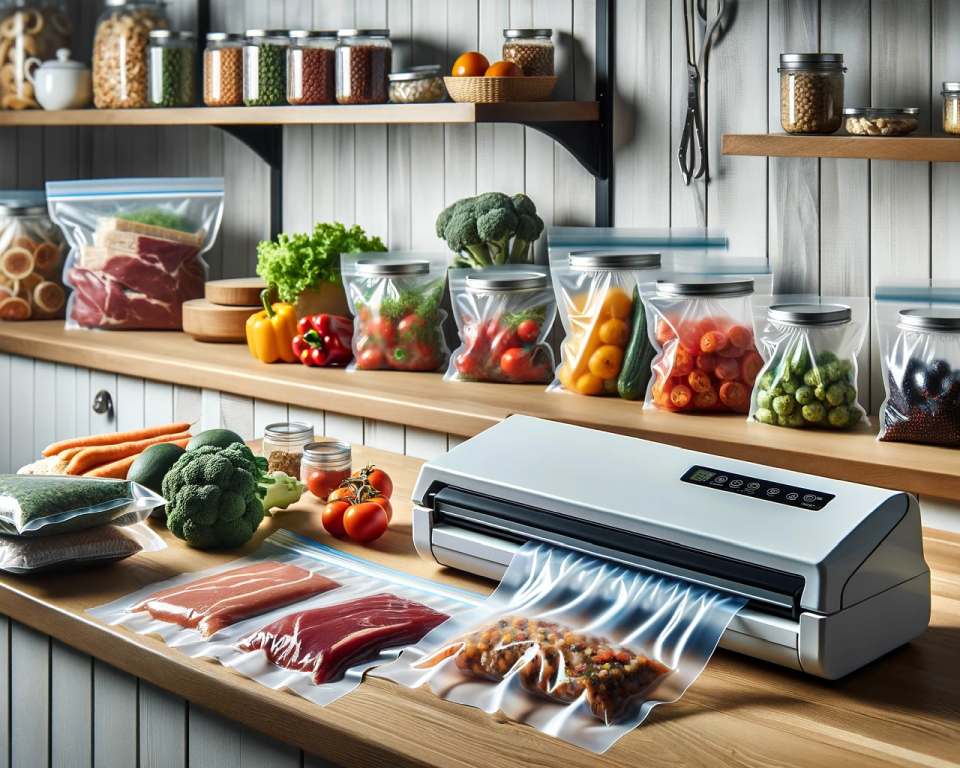
Mylar Bagging
Mylar bagging is a medium-difficulty method of preserving dry goods. It involves using a special type of bag made of Mylar and oxygen absorbers to create an airtight seal. This preservation method is highly effective in extending the shelf life of dry goods for years, making it ideal for storing items like rice, beans, and grains.
The key to successful Mylar bagging is to ensure a proper seal, as any gaps or openings can compromise the effectiveness of the preservation. The use of oxygen absorbers helps create an oxygen-free environment inside the bag, preventing the growth of microorganisms that cause spoilage. This method protects dry goods from moisture, light, and pests, preserving their quality and nutritional content for an extended period.
Properly sealed Mylar bags can add years to the shelf life of your dry food items.
However, it’s important to note that Mylar bagging can be an expensive preservation method compared to other techniques. The cost of Mylar bags and oxygen absorbers can add up, making it a less affordable option for some individuals. Additionally, there is a risk of the bags burning if they are not properly sealed during the preservation process.
Mylar Bagging Tips:
- Use high-quality Mylar bags specifically designed for food storage.
- Ensure the bags are free from any punctures or tears before sealing.
- Use oxygen absorbers appropriate for the size of the bag to maintain an oxygen-free environment.
- Seal the bags tightly, removing as much air as possible before sealing.
- Store the Mylar bags in a cool, dry, and dark place to maximize their effectiveness.
By following these tips, you can utilize Mylar bagging as a reliable and efficient method for long-term storage of your dry food items.
Wintering Over
Wintering over is an easy method of preserving hardy vegetables through the winter months. By utilizing this technique, we can extend the shelf life of our favorite root vegetables for several months, ensuring a steady supply of fresh produce.
To winter over hardy vegetables, such as carrots, potatoes, and onions, we need a cool and dark storage space like a root cellar or cold storage room. These vegetables thrive in low temperatures and require a consistent environment to stay fresh.
When storing root vegetables, it’s crucial to provide proper insulation to maintain the cool temperatures. Consider insulating the storage space with straw or mulch to create an optimal environment for wintering over. This insulation helps regulate temperature fluctuations and keeps the vegetables at an ideal storage temperature of around 32 to 40 degrees Fahrenheit.
By wintering over hardy vegetables, we can enjoy the freshness and nutritional benefits of homegrown produce even during the coldest months of the year. The months of preservation time provided by this method ensure a sustainable and cost-effective food source, reducing our reliance on store-bought produce.
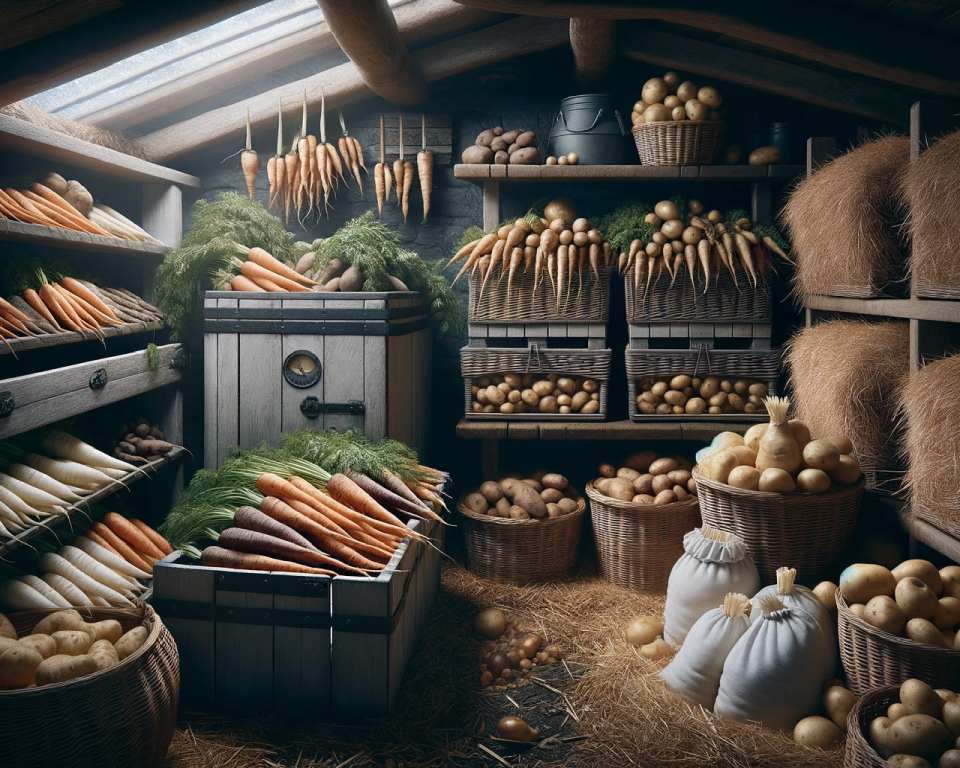
“Wintering over is a reliable method for preserving hardy vegetables, ensuring a continuous supply of fresh produce during the winter months.”
In addition to the convenience and extended preservation time, wintering over hardy vegetables also allows us to enjoy the unique flavors and textures that these vegetables develop during storage. The cold temperatures promote natural sweetness in root vegetables like carrots and enhance the nutty flavors of potatoes and onions.
The Benefits of Wintering Over:
- Extends the shelf life of hardy vegetables for several months
- Provides a continuous supply of fresh produce during the winter months
- Reduces reliance on store-bought produce
- Promotes natural flavors and textures
Incorporating wintering over into our food preservation routine is a rewarding and sustainable practice. By utilizing the suitable storage conditions and taking advantage of the natural hardiness of root vegetables, we can enjoy the taste and nutritional benefits even when the snow is falling outside.
Root Cellars
Root cellars are a versatile and efficient method of preserving a variety of foods. They provide a controlled environment with optimal humidity and temperature levels, ensuring the long-term storage of vegetables, canned goods, ferments, and dried foods. This traditional preservation method requires an initial investment to build or modify a suitable space for a root cellar, but the benefits are well worth it.
By utilizing a root cellar, you can extend the shelf life of your vegetables and other food items by several months. The consistent cool temperature and high humidity help to slow down the natural process of spoilage, keeping your produce fresh and nutritious for longer periods. Plus, the darkness of the cellar helps to preserve the quality, flavor, and nutritional value of the stored foods.
Root cellars are particularly ideal for storing a wide range of vegetables, including root crops like carrots, potatoes, and onions. The cool, dark environment mimics the conditions found in the ground, effectively creating an artificial winter that allows these hardy vegetables to last beyond their usual harvest time. Additionally, the root cellar can also accommodate other long-lasting food items such as canned goods and dried foods, providing a convenient and all-in-one storage solution for your preservation needs.
FAQ
What is freezing?
Freezing is a method of food preservation that involves storing a wide variety of foods in a freezer for extended periods. It helps prevent spoilage but can lead to freezer burn if not properly sealed.
How does freezing extend the shelf life of food?
Freezing slows down the growth of bacteria, yeast, and molds in food, which helps to extend its shelf life. Additionally, freezing halts enzymatic activity, which can cause food to deteriorate.
Can all types of food be frozen?
Most types of food can be frozen, including fruits, vegetables, and meats. However, some foods may not freeze well and can suffer from texture or taste changes after thawing.
What is vacuum sealing?
Vacuum sealing is a method of removing oxygen from a bag or container to create a seal. It is often used in conjunction with freezing to reduce freezer burn and extend the shelf life of frozen foods.
How does fermentation preserve food?
Fermentation is a natural process where microorganisms convert sugars into acids or alcohol. This process helps to preserve the food by creating an acidic environment that inhibits the growth of harmful bacteria.
Can I ferment all types of food?
Fermentation can be used to preserve a wide range of foods, including vegetables, fruits, grains, and dairy products. However, it is important to follow proper fermentation techniques to ensure safety and desirable flavors.
What is canning?
Canning is a preservation method that involves sealing food in jars and then heating them to kill bacteria and create a vacuum seal. Canned foods can last for years and are suitable for fruits, vegetables, and meats.
Is canning difficult?
Canning can be a more challenging preservation method as it requires special equipment, time, and energy. Proper sterilization and sealing techniques are crucial to avoid the growth of bacteria, particularly the deadly botulism bacteria.
What is drying?
Drying is a method of removing moisture from foods to prevent spoilage. It can be done without electricity and is suitable for fruits, herbs, grains, and meats. Dried foods can last for months and retain their flavor and nutritional value.
How does freeze drying work?
Freeze drying involves freezing the food and then removing the moisture through a process called sublimation. This method results in a long shelf life for food and minimal loss of flavor and nutritional value.
What is vacuum sealing?
Vacuum sealing is a method of preserving dry or frozen foods by removing the oxygen from a bag or container to create a seal. It helps to prevent the growth of bacteria and can extend the shelf life of food for years.
What is Mylar bagging?
Mylar bagging is a method of preserving dry goods, such as rice, beans, and grains, by using special bags made of Mylar and oxygen absorbers. This method creates an airtight seal and can extend the shelf life of dry goods for years.
What is wintering over?
Wintering over is a method of preserving hardy vegetables through the winter months by storing them in a cool, dark place, such as a root cellar or cold storage room. It can extend the shelf life of vegetables for several months.
What are root cellars?
Root cellars are versatile methods of preserving various types of food. They provide a controlled environment with optimal humidity and temperature levels for food storage. Root cellars can be used to store vegetables, canned goods, ferments, and dried foods for several months.

